
Restoring the Ruin
The ancient Greeks took only eight
or nine years to build the Parthenon. Its modern restorers, led by Greek
architect Manolis Korres, have already taken over 30 years and nearly $90 million to
repair and restore it, and their work may not be complete until 2020. Why so
much time, money, and effort? Well, imagine trying to assemble a 100,000-ton,
three-dimensional jigsaw puzzle with 70,000 individual pieces. That's the
task Korres and his colleagues have set themselves, and they are doing it with
the greatest care and sensitivity, striving to strike the right balance between
putting it back together and leaving it the majestic ruin it is. In this slide
show, see the extraordinary lengths to which the Acropolis Restoration Project team is
going—as well as the perhaps surprising degree to which they rely on ancient Greek
techniques.—Gary Glassman
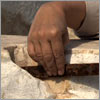

|
|
Undoing past doings
Before the restoration team could
begin, they had to take apart, block by block, and repair nearly every piece of
the Parthenon. That's because early restorers, most notoriously a Greek
engineer named Nikaloas Balanos who led restorations from the late 1800s to the
mid-1900s, put column drums and whole blocks back in the wrong place. Even more
damaging, Balanos used iron clamps like the one seen here to hold blocks
together. The ancient Greeks had done the same, but they had coated their iron
with lead to prevent rusting. Balanos's uncovered clamps corroded and
expanded, cracking and even destroying the marble.
|
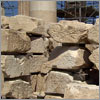

|
|
Locating all original pieces
In order to create the most
faithful restoration, the team has sought from the beginning to salvage
whatever ancient marble blocks have survived. This has been easier said than done.
Tens of thousands of original pieces exist, some scattered around the
Acropolis, others around the world, and still others lost forever. Whatever
pieces the team is missing they have to recreate.
|
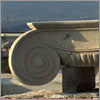

|
|
Cataloguing remains
Korres's team created a
computer database of all original pieces. By entering, in some cases, over 50 criteria
to identify each piece—among them height, width, slope, corrosion,
cracking, stain marks, and even graffiti—they hoped the computer could
aid them in finding each remnant's original position on the building. But often
differences in the pieces are so subtle that they must abandon the computer and
match fragments by eye.
|


|
|
Determining where each piece
goes
Although the Parthenon might appear
to be geometrically straight and built from interchangeable parts, it is not.
The ancient Greeks worked subtle curves into the columns, architraves, floors,
and other architectural elements, possibly to make the building appear more
"alive" or to counteract optical illusions of sagging that parallel
lines (like roof and floor lines) can cause. As a result, each of the
Parthenon's 70,000 pieces is unique and fits in only one place.
|


|
|
Acquiring new marble
To replace original pieces that are
missing, because they either have been looted and are now in museums around the
world or have altogether disappeared, the team has turned to the very quarry
the ancient Athenians used. Just 12 miles from the Acropolis, the quarry is
known as Pentelicon. Scholars estimate that in the time of Pericles, the
Athenian leader who spearheaded the Parthenon's construction, workers cut
100,000 tons of marble from Pentelicon. The quarry remains a rich source of
marble even today.
|
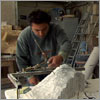

|
|
Shaping missing pieces
Before carving a new piece of marble to fill a gap,
team members first fashion a plaster cast of the absent piece. As they have in
many instances throughout this project, they then turn to an ancient tool and
technique. They use an antique mason's device called a pantograph, seen
here, to record the three-dimensional shape of the cast. They then
painstakingly transfer that shape, point by point, to the new marble.
|
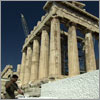

|
|
Carving new pieces
As in ancient times, the Parthenon
workplace today is less a construction site and more a sculptor's studio.
Master stonemasons do all carving by hand. Their expert skills are needed,
because sometimes the difference between a piece fitting perfectly and not
comes down to just a tenth of a millimeter, about the thickness of a human
hair. Amazingly, the ancient Greeks themselves achieved this level of
precision, in part by using highly sophisticated tools. Korres, by studying
tool marks in old marble, has reconstructed ancient chisels and other tools that he believes
were, in their day, sharper and more durable than similar tools today.
|
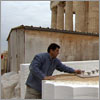

|
|
Finishing new marble
To level a new surface, the
team's masons again turn to an age-old technique. They sprinkle sand onto
the surface, then use a metal smoothing plate to work out imperfections. The
plate is an ancient invention, its modern counterpart based on stone plates
found on the Acropolis. Korres believes that those early plates could grind to
a precision of one-twentieth of a millimeter. Today, final sanding of distinctive features such as the column flutes seen here is done by hand using sandpaper.
|


|
|
Mating two pieces
When it's time to fit a newly
fashioned piece of marble with a broken or irregularly shaped ancient one, the
team once again borrows from Periclean times. To ensure that the new piece
exactly snuggles against the old, they coat the inner surface of the new marble
with red clay. They gently push the two pieces together, then pull them apart.
Points on the new piece that turn white—that is, where the clay is
scraped off—indicate spots on the new slab that need fine-tuning. The
operation is repeated dozens of times until the new marble precisely matches
the ancient surface.
|


|
|
Aligning the drums
Stacking and aligning column drums is another challenge. When Korres's crew separates two original drums for the first time in 2,500 years, they discover the ancients' ingenious solution. When mating two drums, the Athenians carved two pieces of cedar, one fitting inside the other like a key into a lock. These were set into holes cut in the center of each drum; when one drum was lowered onto the other, the cedar ensured proper alignment. Here, architect Cathy Paraschi displays three pairs: an original set (at left, still smelling of cedar), a modern copy (stacked at center), and a pair made out of titanium for use in today's restoration.
|
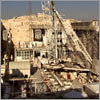

|
|
Using modern equipment
Of course, Korres and his team rely
on many pieces of modern equipment as well, everything from soaring cranes to
lift multi-ton capitals to the top of columns, to diamond-tipped saws to cut
through fresh marble in the quarry. But without the ancient tools and
techniques, the project arguably could not reach the level of perfection that
the ancient Athenians achieved.
|


|
|
Restoring a ruin
When the Acropolis Restoration
Project began 30 years ago, Manolis Korres and his colleagues could have chosen
to approximate the Parthenon's original state, adorning it with
sculptures and friezes, and painting it in vivid colors. Instead, they decided
to preserve what has survived for two and a half thousand years—a
majestic ruin, a witness to what we needlessly destroy, and the beauty and
perfection that we can create.

|
|


We recommend you visit the interactive version. The text to the left is provided for printing purposes.
|













